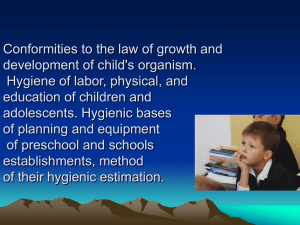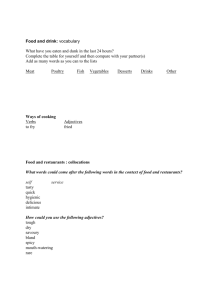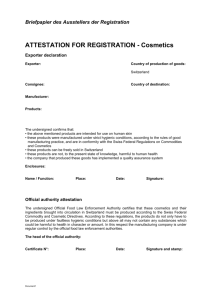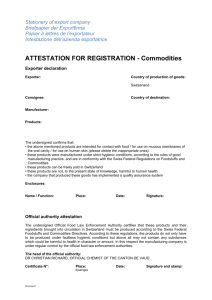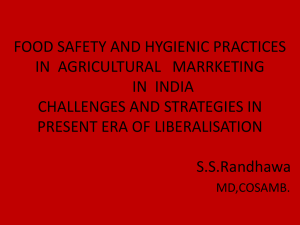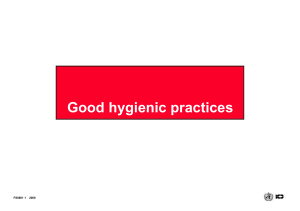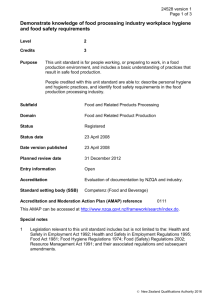For foreign students the II year of of dental faculties
advertisement
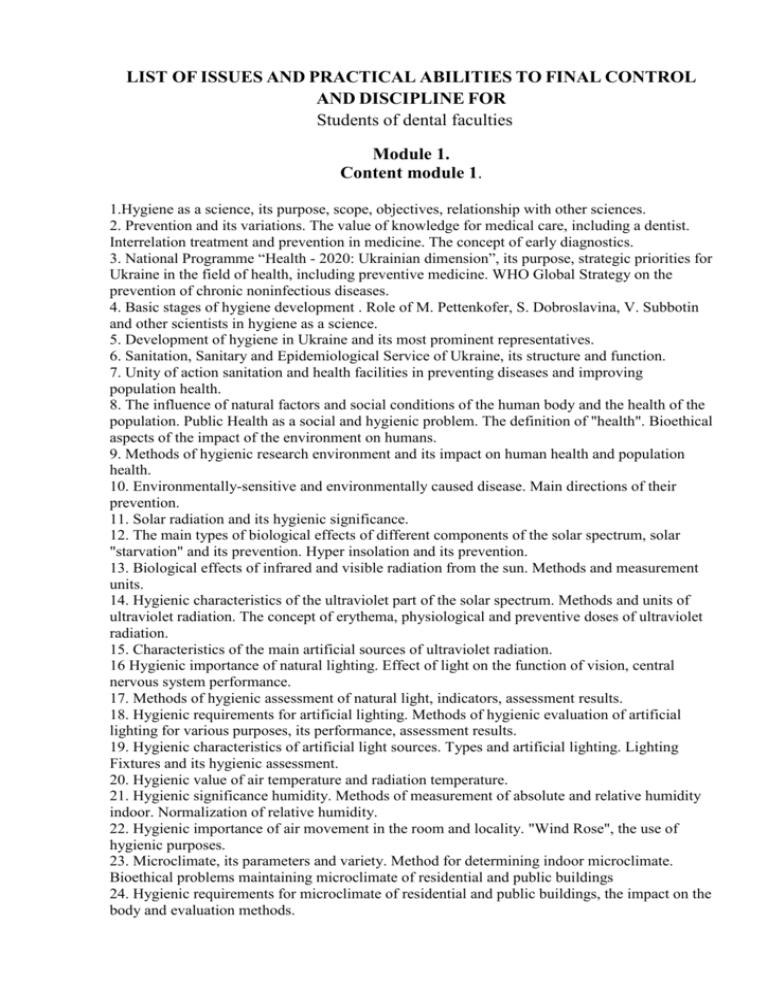
LIST OF ISSUES AND PRACTICAL ABILITIES TO FINAL CONTROL AND DISCIPLINE FOR Students of dental faculties Module 1. Content module 1. 1.Hygiene as a science, its purpose, scope, objectives, relationship with other sciences. 2. Prevention and its variations. The value of knowledge for medical care, including a dentist. Interrelation treatment and prevention in medicine. The concept of early diagnostics. 3. National Programme “Health - 2020: Ukrainian dimension”, its purpose, strategic priorities for Ukraine in the field of health, including preventive medicine. WHO Global Strategy on the prevention of chronic noninfectious diseases. 4. Basic stages of hygiene development . Role of M. Pettenkofer, S. Dobroslavina, V. Subbotin and other scientists in hygiene as a science. 5. Development of hygiene in Ukraine and its most prominent representatives. 6. Sanitation, Sanitary and Epidemiological Service of Ukraine, its structure and function. 7. Unity of action sanitation and health facilities in preventing diseases and improving population health. 8. The influence of natural factors and social conditions of the human body and the health of the population. Public Health as a social and hygienic problem. The definition of "health". Bioethical aspects of the impact of the environment on humans. 9. Methods of hygienic research environment and its impact on human health and population health. 10. Environmentally-sensitive and environmentally caused disease. Main directions of their prevention. 11. Solar radiation and its hygienic significance. 12. The main types of biological effects of different components of the solar spectrum, solar "starvation" and its prevention. Hyper insolation and its prevention. 13. Biological effects of infrared and visible radiation from the sun. Methods and measurement units. 14. Hygienic characteristics of the ultraviolet part of the solar spectrum. Methods and units of ultraviolet radiation. The concept of erythema, physiological and preventive doses of ultraviolet radiation. 15. Characteristics of the main artificial sources of ultraviolet radiation. 16 Hygienic importance of natural lighting. Effect of light on the function of vision, central nervous system performance. 17. Methods of hygienic assessment of natural light, indicators, assessment results. 18. Hygienic requirements for artificial lighting. Methods of hygienic evaluation of artificial lighting for various purposes, its performance, assessment results. 19. Hygienic characteristics of artificial light sources. Types and artificial lighting. Lighting Fixtures and its hygienic assessment. 20. Hygienic value of air temperature and radiation temperature. 21. Hygienic significance humidity. Methods of measurement of absolute and relative humidity indoor. Normalization of relative humidity. 22. Hygienic importance of air movement in the room and locality. "Wind Rose", the use of hygienic purposes. 23. Microclimate, its parameters and variety. Method for determining indoor microclimate. Bioethical problems maintaining microclimate of residential and public buildings 24. Hygienic requirements for microclimate of residential and public buildings, the impact on the body and evaluation methods. 25. Heat exchange with the environment. Ways recoil warm body at different conditions of temperature, humidity and air velocity. 26. Physiological changes in the body and diseases associated with the action re cooling microclimate and their prevention. 27. Physiological changes in the body and disease caused by overheating microclimate effect on the body, measures of prevention. 28. Atmospheric pressure, it changes and their impact on the human body. Prevention of Mountain and High Altitude sickness. 29. Weather. Weather forecast molding and characterize factors. Medical classification of weather. Sanitary protection and bio-safety of the air. 30. The climate and the factors that shape and characterize. Characterization and classification of climate, hygienic items. 31. Acclimatization, acclimatization phase. Features of acclimation in the northern and southern regions. 32. The chemical composition of air, hygienic significance of its individual components. 33. Sources of air pollution. Effect of air pollution on health population and sanitary living conditions. Sanitary protection and bio-safety of the air. 34. Ventilation of the room and its hygienic significance. Natural and artificial ventilation. 35. Urbanization as a social and hygienic problem, the positive and negative consequences. 36. Hygienic importance of water, the effect of water quality and water supply conditions on population health, sanitary living conditions. Bioethical problems of water supply. 37. Classification of water sources and their characteristics. 38. Sources of water pollution and water purification processes of water . Indicators of pollution and its self-purification of water reservoirs. 39. Water as a etiological factor of diseases with infectious nature, including violations of state formation and dent alveolar apparatus. 40. Infectious diseases transmitted by water, their classification by WHO. Features water epidemics and storm , their prevention. 41. Hygienic importance of fluoride drinking water. Caries, endemic fluorosis conditions of their occurrence and prevention. 42. Diseases caused by the peculiarities of macro-and trace-element composition of water. 43. Endemic fluorosis, its stage, water-nitrate methemoglobinemia. 44. Indicators of organoleptic properties of water, its hygienic significance and use in sanitary examination of water sources. 45. Bacterial and chemical indicators of water pollution. 46. Methods of conditioning water quality. Coagulation, sedimentation, filtration, disinfection of water. 47. Fluoridation water as a hygienic problem. Interaction dental and sanitation services in matters related to the implementation and realization of water fluoridation and study its Anticavity efficiency. 48. Rationing the quality of the water as a way to prevent disease population, related to the water element. State Standard number 400, 2010 49. Technical progress and pollution of water reservoirs chemicals. Sanitary protection of reservoirs. 50. Zones of sanitary protection of water sources , their importance in improving of water quality. 51. Hygienic importance of soil. Sources of pollution of soil and its purification. Contamination of soil with chemicals, the measures of their preventions. Bioethical problems of hygiene of soil. 52. Liquid and solid wastes of inhabited cities, their sanitary and epidemiological significance. Modern hygienic and bioethical issues clearing populated areas. 53. Methods and facilities for cleaning and disinfecting liquid domestic wastewater. 54. Principles of treatment populated areas. Systems and structures for temporary storage, removal, disposal and recycling of solid waste. 55. Modern methods of disposal and utilization of solid scum (plants for their processing and utilization, improved landfill, composting methods, bio-thermal cameras and other). Semantic module 2. 1. Nutrition as a social and hygienic problem. The main functions of food. Bioethical aspects of healthy human nutrition. 2. The concept of a balanced diet. Principles of good nutrition. The principles of nutrition for people of different age groups, occupations, athletes. 3. "Norms of physiological needs of the population of Ukraine in the nutrients and energy." 4. Physiological and hygienic significance of protein in the diet, the body necessity of them, their main source. 5. Classification of protein deficiency. Clinical signs of excess and shortage of protein in the diet. 6. Physiological and hygienic significance of fat in the diet, the need for them. Dietary fats of animal and vegetable origin, their nutritional and biological value. 7. Classification of fatty acids. Functions of PUFA, sources of income. The role of PUFA ω3. 8. Physiological and hygienic importance of carbohydrates in the diet, the need for them, their main source. 9. Classification of carbohydrates. The concept of the sugar index. 10. Functions of fiber daily requirement. 11. Physiological and hygienic importance of vitamins in the diet, the need for them, the main sources of income. 12. Causes of vitamin deficiency. 13. Mineral salts (calcium, iron, phosphorus, etc.), their physiological and safety values need. The main sources of macro-and micronutrients. 14. Reasons for failure of minerals in the body. Demineralization factors. 15. Classification of nutritional diseases. 16. Hygienic importance of nutrients (proteins, carbohydrates, minerals, vitamins), food in the prevention of dental diseases. Nutritional caries provoking factors. 17. Diet, its components, scientific evidence for different populations and under different conditions. 18. The concept of nutritional status, method of assessment types. 19. Methods of studying human energy, units of energy. 20. Methods for assessing the adequacy of food hygiene. 21. Methods of medical-hygienic study of nutrition and individual groups. 22. Quantitative and qualitative usefulness of nutrition. The concept of balanced diet. Method of estimation of dietary intake by the menu-layout. 23 .. Food and biological value of foods of plant origin: grains, legumes, vegetables, fruits, berries, use a balanced diet. 24. Food and biological value of animal products (milk and milk products, meat and of meat products, fish and fish products), their hygienic evaluation. 25. The concept of therapeutic and preventive nutrition. Food health-care setting. Classification. 26. Dietary food in the treatment of dental diseases. 27. Food poisoning, classification, measures of prevention. The concept of bio food. 28. Food poisoning, etiology, pathogenesis, occurrence conditions, preventive measures. 29. Food poisoning, etiology, pathogenesis, occurrence conditions, preventive measures. 30. Food poisoning food, poisonous in nature and products that have become toxic properties under certain conditions, preventive measures. 31. Food poisoning impurities of chemicals in food, prevention. 32. Food mycotoxicosis, prevention. 33. Methods of investigation of food poisoning. 34. The concept of food additives, their classification, purpose and application in food industry. The concept of biologically active additives. 35. The concept of genetically modified foods. Socio-hygienic problems associated with the use of food additives. 36. Hygienic bases of the nutritional status of patients in hospitals, especially when damaged dent-alveolar apparatus. 37. How food with the emergence and development of major dental diseases. 38. Alimentary prophylaxis of common dental diseases. 39. Health and hygiene of children and adolescents. Acceleration in modern conditions, hygiene problems associated with it. 40. Methods and evaluation of health of children and adolescents under the influence of environmental factors. Criteria for a comprehensive assessment of the health of children and adolescents 41. Groups of children's health, their characteristics. 42. Factors that shape the health of children and adolescents, their characteristics 43. Modern understanding of acceleration. The concept of biological and calendar age. 44. Methods of hygienic evaluation of physical development of children and adolescents, methods of assessment. Groups of physical education 45. Hygienic bases of the regime of the day the children of different age groups. 46. School maturity. The concept of the daily routine, their types. Activities. 47. Hygienic requirements for planning, equipment, and maintenance of modern educational and recreational facilities for children and teenagers. 48. Hygienic requirements to the educational process in modern facilities for children and teenagers. Prevention of diseases related to the conditions of children and adolescents in educational institutions. 49. Hygienic control over the organization of physical education and labor training of children and adolescents. Semantic module 3. 1. Hygienic requirements for placing the hospital in the village. Requirements for the land and its planning. Zoning hospital site. 2. Comparative hygienic characteristics of modern systems of building hospitals. 3. Intra-hospital infection, conditions that lead to their appearance and their negative consequences. Methods and means of prevention. 4. The value of internal planning and hospital departments to ensure hygienic conditions of stay of patients and staff labor. 5. Ward section, its composition, ward, options for its layout and equipment for infectious patients 6. Dental clinic. Hygienic requirements for construction and operation of branches therapeutic, surgical and prosthetic dentistry and dental laboratory. 7. Hygienic bases of sanitary-epidemiological regime in dental health care settings. Prevention of intra-hospital infections. 8. Hygienic requirements for dental equipment, instruments and rules for its maintenance and decontamination. 9. Methods for objective monitoring of compliance with health and safety conditions in dental schools. 10. Hygienic characteristics ward section, the requirements for a set of premises, the purpose of each. 11. Hygienic requirements for planning the reception office hospitals. Features reception sick, children, mothers. The value of planning and usage admissions offices hospitals 12. Hygienic requirements for planning, construction and maintenance of operating units. 13. Work as a social and hygienic problem. The concept of work and labor. Physical and mental work. Bioethical issues labor. Occupational health professionals dental schools. 14. Industrial hazards and occupational diseases. Classification of hazards. 15. Physiological changes in physical and mental labor. Fatigue and exhaustion. Fundamentals prevent fatigue. 16. The severity and over strain of the labor criteria to characterize use for regulation of working conditions. 17. Hygienic characteristics of work and professional dentists in various fields and dental technicians. Bio-safety and bioethics labor dentists. 18. Forced posture and strain specific groups of muscles as a professional hazard. Prevention of diseases caused by forced body position in the dentist and dental technician. 19. Dust production as harmful, the sources of its formation, the effect of dust on the body depending on the composition, concentration, dispersion, shape of dust particles. Preventing the harmful effects of dust on the body in a dental technical laboratories dental clinics. 20. Chemical factors of the working environment in the dentist and dental technician (mercury, lead, plastics, etc.). Diseases caused by them, prevention. 21. Biological factors, bacterial pollution and instruments in the dental hospital, prevention of harmful effects. 22. Noise as a production harmfulness, its physical characteristics, the impact on the human body. General principles of valuation of noise in the workplace, particularly in the workplace dentist in a dental clinic (office). 23. Prevention "noise" disease and other diseases caused by the factors of the wave nature of the body in health care settings, including dental. 24. Vibration as a manufacturing harmful, effects on the body, prevention, particularly in the workplace dentist. 25. Industrial poisons, their ways of penetration in to the body. Pathology, caused by their action. Methods of investigating occupational poisoning, measures of prevention. 26. Acute and chronic occupational poisoning. Industrial poisons in the dentist and dental technician. 27. Microclimate in manufacturing. Diseases caused by the influence of unfavorable microclimatic conditions on the body. General principles of regulation microclimate in premises. 28. Basic principles of prevention of occupational diseases .. 29. Hygienic principles of a healthy lifestyle. Personal hygiene in modern conditions. 30. Body hygiene and oral health. Oral hygiene and hygienic evaluation. 31. Values and ways of prevention hypo-kinesis in modern conditions. Hygienic requirements for places physical training. 32. Hardening as an element of personal hygiene. Principles of hardening. 33. Hygienic values for the day. Hygiene rest and sleep. 34. Medical and social significance of bad habits, to prevent their occurrence. 35. Hygiene mental labor. 36. Hygienic requirements for textiles, garments and footwear. Comparative hygienic characteristics of natural and synthetic fabrics. 37. The concept of the ionizing radiation dose and units of measurement. Qualitative and quantitative characterization of ionizing radiation and its sources. 38. Classification of ionizing radiation in nature and origin. 39. Biological effects of ionizing radiation. Modern understanding of its mechanisms, the conditions on which it depends, its features. 40. Conditions that determine the radiation hazard when working with radio-nuclides and other sources of ionizing radiation. 41. Radiation hazards and protect workers when dealing with open and closed sources of ionizing radiation in medical institutions. 42. Securing personnel ray departments (offices). Radiation control, its types. Measures of protection from excessive x-ray exposure. 43. The concept of a combined, integrated and combined action of harmful factors. Features of their exposed to the dentists and dental technicians. 44. Radiation safety of patients and staff in radiological studies in dentistry. Principles of radiation danger. 45. The main types of radiation damages the body, if they occur, prevention. Bioethical aspects of the impact of radiation on humans. 46. The concept of emergencies, natural and man-made disasters. 47. Environmental and health consequences of disasters, including the Chernobyl disaster. 48. Sanitary measures in the hearth emergencies. PRACTICAL skills that for the STUDENTS from Hygiene and Ecology 1. Evaluate the performance indoor microclimate, including dental schools (temperature, humidity, air velocity and radiation temperature). 2. To determine the state of indoor lighting, including dental schools (light ratio, coefficient of natural lighting, etc.). give him a hygienic assessment. 3. Determine the status of artificial indoor lighting, including dental schools (level of illumination uniformity it, etc.) to give him a hygienic assessment. 4. To determine the intensity of ultraviolet radiation biological method to calculate its erythema and preventive dose. 5. To estimate the noise level in the room for the research. 6. Giving hygienic evaluation of air pollution from dust, chemicals, micro-organisms by laboratory studies. 7. Giving hygienic assessment of ambient air space according to laboratory research. 8. Interpret meteorological, synoptic and hellio-geo-physical performance forecast, identify medical type it, make medical prognosis and make recommendations for prevention helliometeo-trophic reactions. 9. Giving hygienic evaluation of water quality on the basis of survey water sources and laboratory analysis of samples taken. 10. To determine the optimal concentration of fluoride for water fluoridation in specific geochemical and climatic conditions. 11. Evaluate the sanitary condition of the soil survey area and bacteriological and helminthological analysis of the sample. 12. To be able to conduct techs survey of medical institutions, including dental clinics and offices, giving hygiene recommendations to improve their health status. 13. Evaluate sanitary operating mode, Dressings, ward sections, wards, make recommendations to improve its sanitary condition. 14. Giving hygienic assessment of usefulness of food on the menu-layout and suggestions for improvement. 15. Expect daily energy consumption of a particular person or a closed group (a traditional method and according to WHO recommendations) and determine the needs of the organism (closed group) for nutrients. 16. Identify, assess the nutritional status of human nutritional diagnose disease, determine the causes of status, to communicate with dental diseases. 17. To be able to investigate food poisoning, design appropriate medical records. 18. To determine the severity, intensity of labor based on research findings, make recommendations to prevent fatigue and improvement of working conditions, including health personnel dental clinics (cabinet). 19. To be able to investigate occupational poisoning, design appropriate medical records. 20. Giving hygienic assessment of the physical development of children and adolescents, to determine the identity of a particular child to the group health and make recommendations for its improvement. 21. Evaluate the profile of physical development of children and adolescents to make recommendations to improve their health. 22. Giving hygienic assessment classrooms, school furniture, to determine compliance with their age and anthropometric characteristics of children and adolescents. 23. Organize and prepare plans for periodic medical examinations and testing of employees of medical institutions (radiologists, dental technicians, and others.) Make recommendations for their improvement. 24. Master the techniques of sanitary educational work among different population groups. 25. Assess the radiological situation in radiological departments and offices, giving hygiene recommendations to address excessive exposure to personnel. The chief of common hygiene department Professor V.I.Fedorenko Doctor of medicine science
